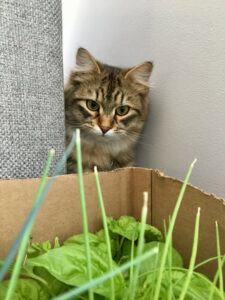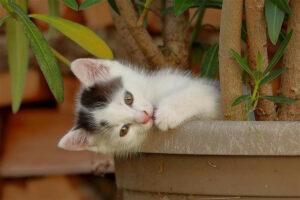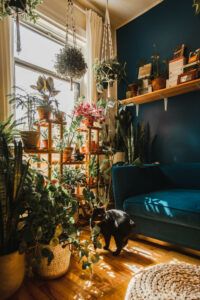
Hello, Cat Enthusiasts!
Do you love house plants as well as cats but your cat keeps methodically destroying your indoor garden? Then let’s find out how to keep a cat away from house plants (and vice versa).
In this article we are going to discuss 11 different ideas, starting from improving your cat’s life and ending with creating a separate space for plants.
How To Keep a Cat Away From House Plants?
Try the following strategies:
- Grow some cat grass to distract your cat from house plants
- Check the litter box
- Provide more toys and enrichment for your cat
- Check your cat’s health
- Use smell and taste deterrents
- Use tactile deterrents
- Grow cat repelling plants
- Use hanging baskets and wall planters to elevate your plants
- Use floating shelves and hanging stands if you have many plants
- Build an indoor greenhouse and get bird cage planters
- Create a plant-themed room
Provide a Healthy Alternative

First of all, try to understand why your cat might attack plants. Depending on their activity, cats might be interested in house plants because:
- they are looking for a grass to eat (if cats actually eat plants)
- they aren’t happy with the litter box (if cats dig in the pots or use them as a litter box)
- they just need something to chew (if cats chew on plants)
- they aren’t satisfied with their environment or they are missing attention (if cats sleep in pots, play with plants, knock them over, tear the leaves)
- they have health issues (if cats eat soil)
Observe your cat’s behavior and try to determine what your cat is trying to tell you with its behaviour.
If the reason of your cat’s unwanted behavior is beyond obvious or you notice sudden changes in behavior, consult with a veterinarian.
Grow Cat Grass
Eating grass is natural for cats and it’s a very common reason why your cat may munch on house plants. If your plants is the only source of greenery in your house, your cat will likely eat them to fulfill its need. In this case, consider growing some cat grass specifically for your cat.
Cat grass is grown indoors from wheat, rye, barley and oat seeds mixture. It is completely safe and has many benefits for cats.
You can find cat grass kits, which typically include seeds, soil, a container and instructions, or ready grown cat grass at your local pet store.
Keep the cat grass tray separate from your plants and replace it with a new tray of fresh cat grass regularly (typically every 14 days). There is a good chance that your cat will love its own patch of greenery and leave your other house plants in peace.
Check the Litter Box
Digging is another example of cats’ natural behavior. Ideally, cats dig only in their litter boxes to cover their waste. If your cat prefers digging in potted plants or using pots as the litter boxes it may indicate that something is wrong with its regular toilet.
Cats may avoid their litter boxes for a variety of reasons, including inability to use the litter box or certain medical problems.
ASPCA has a comprehensive guide for litter box problems which will help you to identify your cat’s problem and deal with it.
The litter box is a very important part of a cat’s life. Make sure your cat is healthy and doesn’t have any problems associated with the litter box.
However, keep in mind that litter box problems is a common – but not the only one – cause of digging in pots.
Provide More Toys and Enrichment
- Chewing is cats’ normal behavior. They may chew on plants because they like the texture of leaves or there is nothing else for them to chew. In this case, get chew toys and chew treats for your cat to distract it from leaves. However, sometimes cats develop a chewing habit because of health problems (gum or periodontal disease or stomach upset). Chewing can also be a sign of stress and anxiety. If there is something unusual about your cat’s chewing behavior, consult with your veterinarian.
- Cats may rest or even sleep in plant pots because they don’t have enough space to rest or sleep (or they are not comfortable with space they have). Cats also can use soil in pots to cool themselves when they feel hot. Some cats prefer resting in pots because they are bush dwellers and enjoy hiding in a tall grass or under the leaves. Make sure your cat has a safe and comfy sleeping area. You can also consider making an indoor grass bed for your cat. Probably all cats enjoy sleeping or playing in grass, so your cat is likely going to absolutely love it.
- Sometimes cats play with plants because they get bored or don’t have enough playing space or toys. Cats need some entertainment and exercise for mental and physical health. Consider creating a playground or a cat tree for your cat. It will provide more territory, scratching surfaces, resting and playing areas to fulfill your cat’s behavioral needs, such as hunting and exploring.
- Cats may attack plants for attention. If your cat is looking for a way to actually destroy your plants (e.g. tears the leaves or knocks pots over), it may indicate that your cat is angry or jealous. For example, if a new plant occupies its favourite resting place or worse – a favourite window. Or maybe your cat just wants your company – sometimes cats feel lonely and abandoned, just as we do.
Check Your Cat’s Health
Sometimes cats display really strange behavior. For example, they may eat nonfood items, including soil. Such a behavior is called pica syndrome. It can be caused by nutritional deficiencies, parasites, viruses, physical or mental disorders.
Eating soil is unsafe to cats as it contains bacteria, pesticides and parasites. In addition, there can be small stones or sharp particles which can cause gastrointestinal blockage or perforation. If your cat eats soil, it’s important to visit your veterinarian to determine the cause of this behavior.
Sudden changes in cat’s behavior and nutritional preferences can also indicate that there is an underlying medical issue. For example, a cat suddenly starts eating large amounts of house plants (or a specific house plant). If you’ve noticed something unusual in your cat’s behavior, get it to the veterinarian for proper examination.
Get Your Cat to Avoid Plants Using Different Deterrents

If your cat has access to its own cat grass, clean litter boxes, a variety of toys to chew, if it is healthy and happy but it still keeps destroying your house plants, try to discourage the unwanted behavior using cat deterrents.
The following strategies work on many cats but there is no guarantee that they’ll work on your cat. Each cat is unique and unpredictable. Furthermore, cats are excellent problem solvers and some of them enjoy overcoming obstacles to get what they want so our attempts to change their behavior often become a battle of wills.
Be patient and be consistent – cats need some time to break a habit. And over time your cat will most likely learn to avoid plants.
Smell and Taste Deterrents
Here are several ways to repel a cat from house plants. They’re cheap and safe for both cats and plants.
Citrus cat repellents. Many cats dislike the smell and taste of citrus. That is why citrus smells are widely used as cat deterrents. One of the easiest ways to keep cats away from plants is to put some orange, lemon or lime peels on top of the soil or scatter them around the potted plants and replace them with fresh peels every few days. Another way is to create a spray for plants using citrus juice diluted with water.
Coffee grounds. Some cats dislike the strong smell of coffee. Put some fresh coffee grounds at the pot feet. You can also put coffee grounds on a paper or wrap them in a piece of cloth and leave them on top of the soil. Repeat every day with fresh coffee grounds.
Cinnamon. Place several boiled cinnamon tea bags at the pot feet.
Bitterant spray and spicy-hot spray. These taste deterrents are particularly useful if your cat likes chewing on leaves. Spray it on the plants and reapply regularly.
Tactile Deterrents
Cats don’t like to walk on rough, prickly, crunchy, sticky and uneven surfaces. The following strategies are particularly effective to discourage digging in pots.
Rocks and seashells. Cover the soil with decorative rocks or seashells. Use a net to hold them in place if your cat tries to take them out.
Forks and chopsticks. Stick some plastic forks into the soil tine side up. You can also use chopsticks or any other sticks with dull points.
Tin and aluminum foil. Foil is a well-known cat deterrent. Place some pieces of foil on the floor (or another surface) between the pots or wrap the foil around the plant.
Double-sided tape or duct tape. Cats hate sticky surfaces, so wrap double-sided tape around the pots. Or place some pieces of duct tape onto the soil upside down.
Pinecones and pine needles. Some cats dislike the smell and texture of pinecones and pine needles. Put some pinecones into the soil or use the pine needle mulch.
Cat Repelling Plants
Most cats avoid certain plants because of their scent. Grow cat repelling plants and place them strategically among your plants. Here are a few plants that cats dislike:
- Lavender
- Rosemary
- Lemon balm
- Citronella and lemongrass
- Curry plant (Helichrysum italicum)
Move Your Plants out of Your Cat’s Reach

Even if you have an extremely stubborn cat, there is always a room for creativity. Here are several ideas to make your plants unreachable for your cat:
Hanging Baskets and Wall Planters
To make your plants hard to reach, add a new level to your indoor garden. Consider growing plants in hanging baskets (pots) and wall planters. They can be hung anywhere, they look charming and save a lot of space. Just make sure that plants are high enough so that cat cannot jump on them.
Shelves and Hanging Stands
Another option is to put your plants on top of the shelves or kitchen cabinets. If you have many house plants and empty wall space, consider creating floating shelves or hanging stands for them. Choose the area that receives enough light and get creative with your plant collection.
Indoor Greenhouse and Bird Cage Planters
If you have a free corner in the house, consider building an indoor greenhouse. It will protect your plants and it’s easy to maintain and relocate. It’s perfect for sensitive and young plants. Indoor greenhouses come in different styles and sizes.
Bird cage planters are a great way to protect your plants and decorate you home. They can be suspended or placed on the floor, table or windowsill.
Plant-themed Room
To make your plants almost unreachable for your cat, consider creating a plant-themed room – a separate room for plants – and keep the door closed for the cat.
Final Thoughts
There are a lot of options to protect house plants from cats but there is no simple answer – every situation is unique. Try different strategies to see which of them are suitable for you and your cat.
The majority of cats (especially exclusively indoor cats) are sensitive to minor changes in their life and can become destructive if they can’t fulfill their behavioral needs. All cats appreciate attention and respect, and hate competition (even with house plants).
Make sure your cat is healthy and has everything it needs. Leave at least one windowsill empty for your cat and don’t put the plants on your cat’s resting places.
Also, keep in mind that many plants are toxic to cats and make sure your cat can’t reach them.
Did you find a perfect strategy to keep your cat away from plants? Or maybe you wish to share your own method? Anyway, I’ll be happy to read your comment.
Thank You For Reading!
